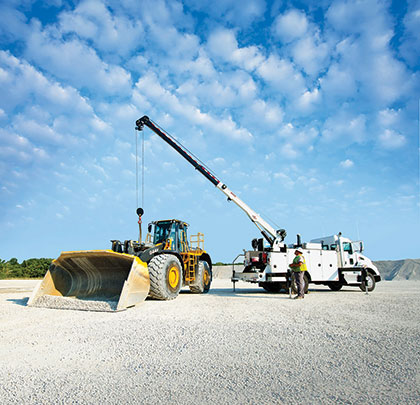A properly inspected and maintained truck minimizes costly downtime
Contractors depend heavily on mechanics trucks to get sidelined equipment back in the dirt and generating revenue. When machinery breaks down or preventive maintenance needs arise, mechanics trucks minimize costly downtime by bringing shop capabilities to the jobsite.
Despite the value of mechanics trucks to productivity and the bottom line, maintenance of the truck body and equipment is sometimes overlooked. Fleet managers should care for mechanics trucks as they do revenue-generating equipment to ensure that the trucks are available and productive whenever they are called upon.
In maintaining a mechanics truck, there are several components a service technician must inspect and service on a regular basis. Iowa Mold Tooling Co. Inc. (IMT) mechanics trucks are typically equipped with a service body, telescopic crane, and air compressor. Each component has its own checklist of items requiring routine attention.
Following are some recommended body, crane, and compressor inspection and service intervals from IMT. It is important that service technicians follow recommendations from the manufacturer of their equipment to limit downtime, promote safe operation, and minimize repair costs.
BODY
Technicians should inspect their service body at least weekly, if not daily, when performing a walk-around inspection. They should look for any hydraulic leaks, broken transportation/safety lights, and cracks in the body’s structure. In addition, they should take the time to check under the body, to ensure there is not any hydraulic plumbing or electrical wiring hanging low or dragging.
Not keeping the service body clean can lead to unsafe working conditions and prevent technicians from noticing potential maintenance problems. If you keep it clean and routinely monitor the truck, typically you can get any cracks or problems with the body rectified quickly and prevent future problems.
CRANE
The crane is the most intricate component of a field service truck, and there are a variety of service-crane inspections that must be done daily, including:
- All safety devices for proper operation
- Controls for leaks, cracks, and proper operation of all functions
- Hydraulic system (hoses, tubes, fittings) for leakage and proper oil level
- Crane hook’s safety latches and proper operation
Additional service-crane inspections and services must be done monthly or after 100 hours of operation, whichever comes first. Recommended monthly inspections include:
- Cylinders for leakage at rod, fittings, and welds, as well as damage to rod and case
- Holding valves for proper operation
- Control valves for leaks at fittings and between stations, and control valve linkages for wear, smoothness of operation, and tightness of fasteners
- Electrical systems for presence of dirt, moisture, and frayed wires
Quarterly service-crane maintenance items must be done every 3 months or 300 hours of operation, whichever comes first, and must also include daily and monthly items. Recommended quarterly inspections and services include:
- Wear pads for general condition
- Rotation bearing for proper torque of all accessible mounting bolts
- Base mounting bolts for proper torque
- Crane structural components (base, stabilizers, mast, inner boom, outer boom, extensions, jib booms, and extensions) for deformation, cracks, and corrosion
Annual service-crane service items must be done yearly or every 1,200 hours, whichever comes first. In addition to the daily, monthly, and quarterly inspection items, services scheduled annually include:
- Changing hydraulic fluid
- Calibrating control and safety valves for correct pressure and relief valve settings
- Checking all valves to ensure they maintain the correct settings
- Inspecting rotation drive system for proper backlash clearance and abnormal wear, deformation, and cracks
WIRE ROPE AND HOOK
There are a number of characteristics to look for in your wire rope. Corrosion might be cause for replacement and at the very least noted and carefully monitored. Other reasons a wire rope might need to be replaced include:
- Three broken wires in one strand or a total of six broken wires
- Flat spots on the outer wires
- A decrease in diameter, which indicates a core failure
- Distortion such as kinking, crushing, or birdcaging
Hooks also are a critical component and must be monitored closely for safety reasons, which is why they are a daily inspection item. A deficient hook must be removed from service right away. Hooks should be removed and repaired if any of the following conditions are present:
- Bending or twisting
- Wear that exceeds 10 percent of the original dimension
- Cracks, nicks, or gouges
- Deformed or malfunctioning latch
COMPRESSOR
IMT mechanics trucks are equipped with either a reciprocating air compressor or rotary screw air compressor. No matter which air compressor model a truck is outfitted with, the airend oil level should be checked daily. Technicians should also make sure the air tanks have been drained of all condensation before using the compressor. Upon starting the unit, technicians should observe that it is building pressure and inspect the fitting and air lines for any leaks.
Oil should be changed in a compressor every 250 service hours or every 3 months, whichever comes first.
CONCLUSION
Mechanics trucks are trusted to minimize costly downtime of equipment that moves dirt and generates revenue. Fleet managers need their mechanics trucks to be ready for safe and productive operation. It is important to carefully follow the manufacturer’s inspection and service recommendations so that mechanics trucks can quickly come to the aid of downed equipment. ■
About The Author:
Terry Cook is the product manager of commercial products at Iowa Mold Tooling Co. Inc. (IMT). He is responsible for leading the company’s line of commercial products and helping drive business strategy for the segment. Cook has worked at IMT for more than 25 years, serving in various roles, including customer satisfaction manager, quality control, technical support manager, quality supervisor, and manufacturing engineer.
_________________________________________________________________________
Modern Contractor Solutions, June 2013
Did you enjoy this article?
Subscribe to the FREE Digital Edition of Modern Contractor Solutions magazine.



